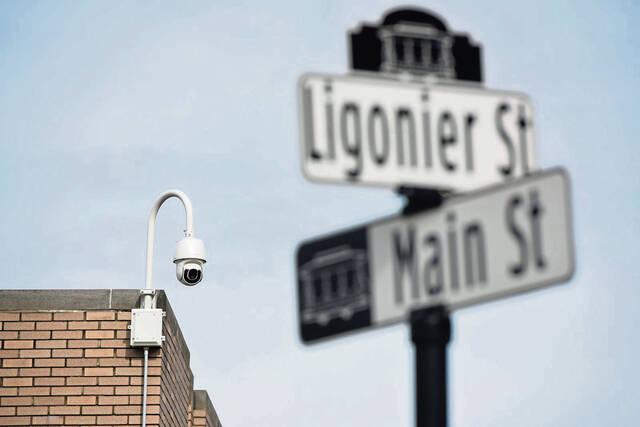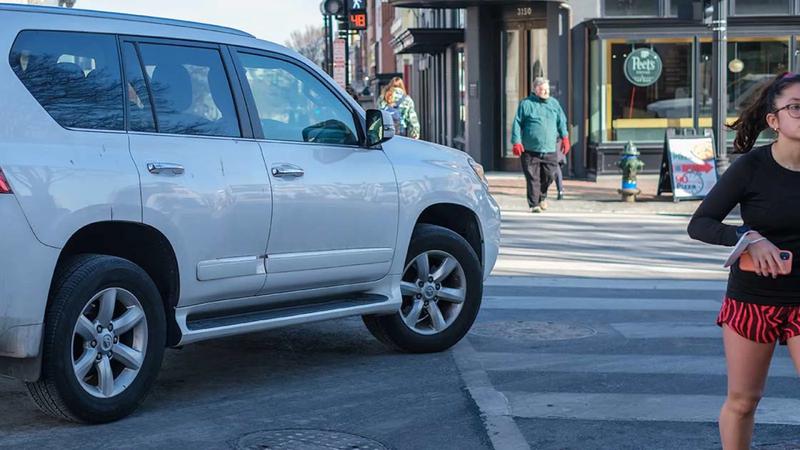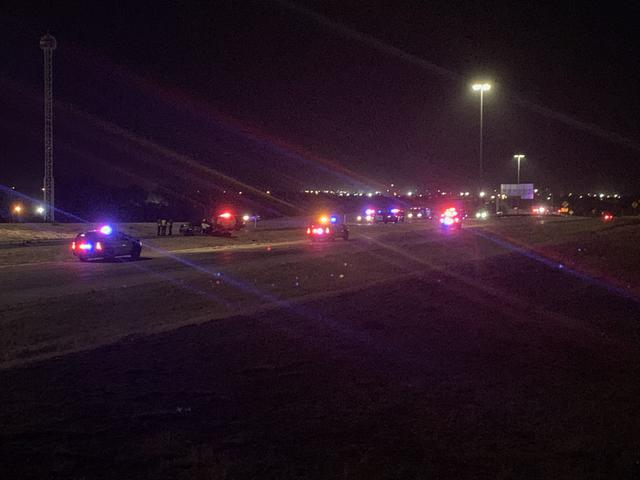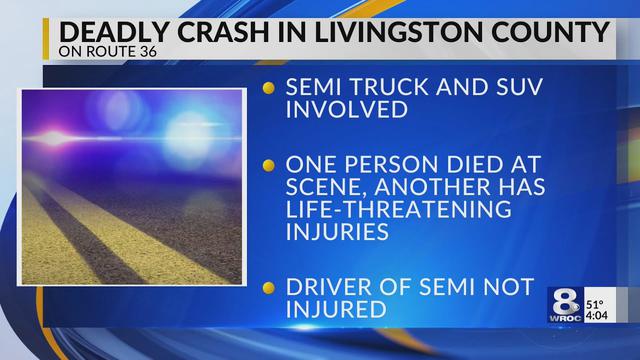When Greensburg police charged two men with a downtown shooting outside The Rialto bar, in which a bystander was wounded in late January, video footage helped investigators identify one of the suspects.
“Without the surveillance video, that may not have been the outcome,” police Chief Shawn Denning said. “With the surveillance cameras outside the courthouse and The Rialto, we were able to get that whole shooting on video.”
Greensburg doesn’t have a dedicated system of surveillance cameras, but the Westmoreland County Housing Authority recently provided the city access to cameras at Eastmont Estates apartments.
“There are several high-quality cameras there,” Denning said. “We did have a (previous) shooting up there, so those cameras would have been extremely beneficial for us to have.
“It gives us access to vehicles coming and going.”
Whether installed by merchants, homeowners or government agencies, surveillance cameras can be found throughout Southwestern Pennsylvania.
Footage has been a boon for law enforcement, providing more evidence police said they can call upon. It also has brought society a little closer to the idea that “Big Brother Is Watching You,” a suffocating level of governmental oversight portrayed in George Orwell’s fictional dystopian tale, “1984.”
Surveillance technology “is being used throughout the county extensively,” said Westmoreland County District Attorney Nicole Ziccarelli, who is in favor of expanding its availability. “I think it’s critically important, both in solving crimes and in prosecuting cases and presenting evidence to juries.”
Financial assistance through the DA’s office has been based on requests from municipalities looking to invest in surveillance cameras. Additional requests for funding likely will continue to be weighed on a case-by-case basis, Ziccarelli said.
“Different municipalities use different types of cameras,” she said. “It’s up to the municipalities to set up their systems.”
Some watchdog groups and researchers have expressed concerns about negative impacts surveillance technology may have on individual privacy.
“It’s very frustrating that this technology is over a decade old, and we still don’t have any statewide legislation that would govern its use,” said Sara Rose, deputy legal director with the American Civil Liberties Union in Pittsburgh. “All of these technologies are being adopted without much disclosure about their use. That’s problematic as they become more ubiquitous.”
Ziccarelli doesn’t have such misgivings.
“I don’t have concerns, based on what I know them to be utilized for,” she said.
Surveillance images have helped Irwin police make arrests in crimes ranging from vandalism to drug offenses to a stabbing, police Chief Dan Wensel said.
“It’s huge for us,” he said. “We rely on the ‘eye in the sky’ to help us in investigations.”
The borough has surveillance cameras installed in its parks. Many downtown businesses have their own.
The borough’s cameras are “top of the line,” Wensel said. “We can see down to the smallest details on a person’s clothing. They’re recording, and if we do have an incident, we’re able to go back several days to find what we need.”
Irwin’s array of park surveillance devices has expanded. Three cameras equipped with zoom and night vision features were installed at Irwin Park in 2012. Donations helped to cover the $10,000 cost. Additional surveillance equipment priced at $7,115 was installed in 2015.
The borough is preparing to install seven high-definition, low-light cameras at the smaller Penglyn Park for $5,500.
“We’ve had several criminal mischief incidents at the park and amphitheater,” Wensel said. “We can get still photos and put those out to the public. We’ve got tips off of that, and we’ve been able to make arrests.”
Helpful tool
The Arnold Police Department installed its first four cameras bought with grant money in 2002 and has been adding more whenever possible, Chief Eric Doutt said. The department now has about 20 cameras that can be monitored by officers at the police station or by using an app, he said.
“They’re an outstanding tool,” Doutt said, noting that security cameras were used in the investigation of a Pittsburgh man on trial recently for a 2019 fatal shooting in Arnold.
The prevalence of private security cameras on homes and business has changed the way officers canvass an area for information about a crime, Doutt said.
“It’s almost become an immediate reaction for officers to go door to door to ask if there is information on the cameras that can help with their investigation,” he said. “Having this tool at our disposal has been a big help.”
Vandergrift also has invested in surveillance cameras for its town park. The borough paid about $1,000, matching a $1,200 donation from businessman and park volunteer Anthony Guerrera, to install six cameras in Kennedy Park last year.
Councilman John Uskuraitis said he was motivated to make the park safer after an incident there in which a youth pulled a knife on Uskuraitis’ daughter, then 9. Since the cameras have been in place, surveillance footage helped authorities identify several minors who damaged bricks on the park stage.
Surveillance video provided more than images when Rostraver police investigated the fatal shooting of a woman by another motorist early Jan. 1 as she drove home from her mother’s house in Fayette County.
Police pieced together footage from at least five residences and businesses, along with witness statements, to identify a Belle Vernon man who they believe went to a bar to continue his New Year’s celebration after the shooting.
According to police, footage showed the victim’s Toyota SUV being closely followed by a Chevrolet SUV — driven by the suspected shooter. Two gunshots were heard on surveillance footage after both SUVs passed by, police said.
Latrobe recently upgraded its system of 56 surveillance cameras throughout downtown and at nearby Legion Keener Park, including about 20 new locations. The Latrobe Foundation, which owns the park, has contributed about $30,000 to the total cost of more than $58,000 for the cameras.
“They are much more advanced than your typical home or business (security) cameras,” police Chief John Sleasman said. “They’re a huge asset for any type of investigation.”
He noted the most sophisticated of the cameras can rotate to provide a 360-degree view at the heart of the city’s business district.
Previously, surveillance footage obtained from businesses and homeowners helped Latrobe police track a vehicle that left the scene of a robbery at a gas stationon Lloyd Avenue. “Eventually, we were able to get a license plate number and identify who it was,” Sleasman said.
With the city’s own cameras, police have ready access to images of high-traffic spots. “We can review the video in a more timely manner,” Sleasman said. “On a weekend, sometimes we can’t get hold of a business owner.”
During the first week after the new cameras were installed, Sleasman said, they helped police solve two hit-and-run accidents, a motorcycle theft and a vandalism case.
In the latter instance, Sleasman said, “There was a young man who decided it would be a good idea to go around town squirting toothpaste into parking meters and the new pedestrian crosswalk buttons. It may seem petty, but it’s going to be an enormous bill” — more than $6,000 to repair the damage.

“Without the new camera system, it would be hit or miss whether we’d be able to solve any of those cases,” he said. “With the new camera system, it was easy. We save the videos; it’s going to make our job a lot easier in court.”
Sleasman would like to add at least two automatic license plate readers at key intersections, if grant funds are available.
“They’re motion-activated. They capture every single vehicle that passes through a particular location.
Allegheny network
Monroeville has been growing its surveillance capabilities in cooperation with the Allegheny County District Attorney’s Office.
In 2016, dozens of surveillance cameras were installed in the community — some with high resolution and license plate recognition technology, along with real-time monitoring and a 30-day backlog for storing images. The cameras cost $4,000 each. The tab was split among Monroeville, Visit Monroeville, the Monroeville Chamber of Commerce and the DA’s office.
There have been more additions, according to police Chief Doug Cole. License plate readers are in place at eight major intersections.
It’s an important tool, he said, because most of those intent on criminal activity arrive in Monroeville by vehicle.
The surveillance devices “help give us starting points for an investigation,” Cole said, providing information officers can access in real time. “We can get descriptions of cars, and we’re able to come up with suspects.”
“If a stolen car hits one of our readers, we converge, and that’s where we’ll find the car.”
Monroeville’s devices are tied in with a surveillance network that spans Allegheny County and was organized by District Attorney Stephen A. Zappala Jr.
That network, which involves municipalities as partners, has grown to about 2,600 cameras — including 600 that are capable of reading license plates — and represents an investment of about $2 million, Zappala said.
The network extends beyond Allegheny to include locations in Westmoreland, Washington, Butler and Beaver counties. Two dozen cameras are located among North Huntingdon, Lower Burrell, and Kiski and Allegheny townships.
Zappala said he plans to meet with the command staff at the state police barracks in Greensburg and with state Senate Majority Leader Kim Ward, R-Hempfield, to discuss further expansion.
“The network eliminates borders and boundaries between municipalities and counties and makes law enforcement more effective and more seamless when dealing with crimes that involve multiple locations or a suspect driving through multiple jurisdictions,” Zappala said.
According to Zappala, surveillance cameras were an important factor in an investigation that resulted in a recent guilty plea involving the 2019 kidnapping and death of a Penn Hills toddler.
“Without the use of cameras, both in our network and from private businesses, detectives from the Allegheny County Police Department would have had a difficult time constructing a timeline of the suspect’s movements,” he said.“While it is always helpful to have private entities cooperate with us for camera footage, that approach depends on our office being, in some cases, lucky enough to have access to private cameras that are working properly and pointed the right way in order to capture what we need.”
Frazer Township’s police force also received financial assistance from Zappala for a new surveillance system, according to police Chief Terry Kuhns. After the system was installed at the Pittsburgh Mills mall complex in March 2017, Kuhns reported an increase in the arrest and conviction rate for shoplifters — from between 25% and 30% up to nearly 90%.
Police used the surveillance system to reassure an older motorist that his car hadn’t been stolen from a parking area. “We could analyze that the car came in, but his vehicle didn’t leave,” Kuhns said. “After about 15 minutes of riding around … we located it. We knew it wasn’t stolen (because of) our advanced system.”
Calls for transparency
In an October letter to Zappala, the ACLU and several other organizations called for his office to be more transparent about its use of surveillance technology. The groups asked that Zappala’s office “provide information regarding who has access to data and information collected from surveillance technology, what safeguards are in place to protect citizens’ privacy, and what measures are in place to preserve and disclose potential exculpatory evidence collected from surveillance technology.”
The groups also asked Zappala to refrain from using facial recognition technology in conjunction with images captured by the surveillance network, noting that technology can be particularly inaccurate when attempting to identify people of color, women and children.
“The use of facial recognition as a law enforcement tactic sends a message that the only way to keep us safe is by treating us as threats to be monitored, tracked and incarcerated, using ever-more-sophisticated technology,” the letter stated.
Zappala’s office told the Tribune-Review it isn’t using facial recognition technology and has no plans to do so.
In past years, Zappala has advocated for use of facial recognition software. In 2011, he said he wanted to use such software with surveillance cameras then being installed on parts of Freeport Road, between Aspinwall and Tarentum, and in the Sheldon Park public housing development in the Natrona Heights section of Harrison.
Carnegie Mellon University professor Alessandro Acquisti co-authored a 2011 study that demonstrated the relative ease of using facial recognition software and pointed to related privacy concerns.
Using that software, researchers were able to match a statistically significant proportion of unidentified profiles from a popular online dating site with known Facebook profile photos. They further showed that the software could be combined with publicly available internet data, cheap cloud computing, data mining and algorithms to not only infer a person’s identity from an anonymous facial image, but to also infer other sensitive information, such as the person’s Social Security number.
Those concerns only have increased in the intervening years, according to Acquisti, as the path from a facial image to matching personal information has become easier.
“Technologies have become cheaper and more powerful,” he said. “And more and more of us today have publicly available images of ourselves and our faces online. The opportunities for surveillance have become commonplace and nearly ubiquitous.”
Issues related to license plate readers are a growing concern for groups such as San Francisco-based nonprofit Electronic Frontier Foundation, whose stated mission is to defend digital privacy, free speech and innovation.
“If they’re not accused of anything and their car is not ‘hot-listed’ as stolen, there’s no reason to collect that much data on every single person driving a car,” Matthew Guariglia, EFF policy analyst, said of plate readers.
The readers, he said, are “blanketing huge swaths of the country. Companies are getting rich selling them to individuals, towns, police departments and community associations.”
When the devices make a mistake reading a plate or a “hot list” isn’t promptly updated, Guariglia said, “There’s a real chance innocent people could be pulled over.
“There are a lot of stories of people getting pulled over in a rental car because it was involved in a crime a day or two ago and nobody updated the list,” he said.
Rose, of the ACLU, expressed concern that plate information from cars in Pennsylvania that aren’t included on a “hot list” and don’t trigger an alert still could remain in a law enforcement database for an undetermined amount of time.That data could be used to invade a person’s privacy, tracking their trips to places such as a medical appointment or an Alcoholics Anonymous meeting, she argued.
“We’re not against the use of license plate readers, but there has to be a policy governing their use,” she said.“Once you get down to that granular level of tracking people everywhere they go, you could have a record of someone’s activities for 10 years.”
Pennsylvania House Bill 133 of 2021, which would establish a grant program to help local law enforcement agencies obtain license readers, would allow such agencies to keep data obtained through the devices for up to one year.
“We think that’s way too long,” Rose said. Among other states that have set retention limits for license data, “Most are around 30 to 90 days, which we think is more reasonable,” she said.
If surveillance data is shared among agencies, she noted, “that makes it even more important that you have policies in place that limit data retention and limit how it’s used.”
Surveillance technology also can have a chilling effect on civic engagement, Guariglia cautioned.
“If you know that the sheriff is going to be on the other side of the camera overlooking the town square, how much less likely are you to go to the square for a protest?” he said. “Maybe it’s a protest against the sheriff.”




